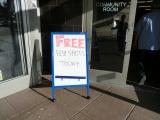Sep 22, 2009 (CIDRAP News) – With the second wave of the H1N1 influenza virus now hitting, much of the response toe the pandemic is focused on the development and distribution of an effective vaccine, a project that poses many challenges and uncertainties.
Responding to the H1N1 virus with vaccines and antivirals was the topic of today's opening plenary session at a 2-day conference in Minneapolis on business preparedness for the pandemic, called Keeping the World Working During the H1N1 Pandemic: Protecting Employee Health, Critical Operations, and Customer Relations.
Michael T. Osterholm, PhD, MPH, director of the University of Minnesota Center for Infectious Disease Research and Policy , publisher of CIDRAP News, moderated a panel of experts and led the discussion with a question that is on the minds of everyone involved in H1N1 preparation: What is the current status of the H1N1 vaccine in the United States?
Distribution to start slowly
The US government has ordered 195 million doses of H1N1 vaccine, and it is anticipated that the vaccine will be available for distribution starting in early October, said Jay C. Butler, MD, director of H1N1 Vaccine Task Force at the Centers for Disease Control and Prevention.
Saying that the initial distribution will not be consistent and that the live attenuated influenza vaccine (nasal spray vaccine) will most likely be the first vaccine available, Butler emphasized that the distribution will start out slowly but ramp up quickly to an average of 20 million doses weekly. By the end of October he hopes 60 to 70 million doses will be distributed.
Currently, only 3.4 million doses have gone through FDA approval and are ready for distribution, or only about 2% of the total. "That is just the beginning of turning on the tap," he said.
Depending on the demand, Butler said there is the capacity to very quickly increase the 195 million doses currently on order to 250 million doses.
What remains unknown is the demand. "Ultimately, we will find out over the next couple of weeks when the vaccine becomes available what the demand is," he said.
Observing that demand for the vaccine will vary by region and by factors such as perceived threats and concerns over vaccine safety, Butler stressed that the most important point about the vaccine is "that we want to be able to make the vaccine available to every American who wishes to be vaccinated."
State and local distribution
Equal to the challenges of developing a safe and effective H1N1 vaccine is appropriate, timely, and efficient distribution. Emphasizing that this is the first time there is a need to rapidly ramp up a vaccine-based program for adults versus children, Osterholm asked the panel to address what is happening at the local and state levels to accomplish this.
Paul E. Jarris, MD, MBA, executive director of the Association of State and Territorial Health Officials (ASTHO), based in Arlington, Va., spoke about the monumental task of getting the vaccine out and the daily round-the-clock effort to pull this off.
Specific issues include identifying the target populations at most risk and in need of the vaccine, as well as different sites for efficiently distributing the vaccine.
Although doctors' offices and other healthcare settings are typical venues for vaccine distribution, Jarris emphasized that there are no clear providers for certain at-risk populations, such as pregnant women and parents of children under 6 months. Hence, he and his colleagues are looking at different venues that may serve these populations.
For example, he said, ob/gyns could give the vaccine to pregnant women at their trimester examinations. Another venue would be pharmacies, which can be a major distribution point once enough of the vaccine is available.
Joshua Rif, MD, MBA, medical director for Minneapolis-based Target Corporation, said the Target retail chain already provides the seasonal vaccine to employees and the public and is letting the government know that its pharmacies are available to deliver the H1N1 vaccine.
Emphasizing that the vaccination effort is a private-public partnership and that distribution will be determined by where a person lives, Ruth Lynfield, MD, state epidemiologist and medical director for infectious disease at the Minnesota Department of Health, said local public health departments are working with a number of venues throughout the state, including hospital systems, ob/gyn clinics, schools, and providers who typically administer the influenza vaccine.
"It is a patchwork approach," she said. "We are trying to do a lot of communication…but it will not be totally smooth."
An overarching challenge to distribution is the fact that the character of the H1N1 flu remains largely unknown–whether it will be a malicious invader or only an annoying house guest. Challenges also remain, said Jarris, in knowing with more certainty how much of the vaccine will be available, what type of vaccine it is, and whom to target. "Until we know that, we can't turn on the distribution," he said.
Race against time
Osterholm emphasized that one important question weighing on the minds of many employers is the timing of the vaccine. Even with the vaccine in the pipeline and a few drips coming out the spigot, the vaccine realistically will not provide immunity to many people probably until November or December. How should employers and others think about this and the unpredictability of this novel strain?
"We have to look at this over time," said Jarris. "The first priority is the highest risk people, how do we get to them."
He said the Americans with Disabilities Act prohibits employers from asking employees about disability. Consequently, prioritizing vaccine distribution by risk factors in the work place cannot be done.
He stressed the importance of looking at this issue over time, as enough doses of the vaccine will be available eventually. He also emphasized that the vaccine is voluntary. "Only if you want it, will you get it," he said.
For Butler, this issue highlights the importance of planning. "Plans are useful, but planning is more useful," he said, adding that the pandemic we are facing is not the one that was planned for. The populations most affected by this pandemic, younger people and pregnant women for example, point to the need to focus on high-risk groups.
This also suggests to the best way to protect the nation's infrastructure, he said, commenting that the infrastructure will not be challenged by workers being out sick but by workers being absent because they are at home taking care of sick children.
Communication is key
Another challenge is the need to address the many concerns about vaccine safety. Osterholm provided a case example of how an employer would address a situation in which an employee is vaccinated and a day later dies of a heart attack.
Butler stressed the huge challenge presented by these types of scenarios and the need for good communication in educating people about what vaccines do and do not cause. Anecdotal reports will circulate, he said, so health officials will need to come up with good data on causation.
See also:
CIDRAP Source conference agenda
http://attendesource.com/profile/web/index.cfm?PKwebID=0x65757d46&varPage=info
















